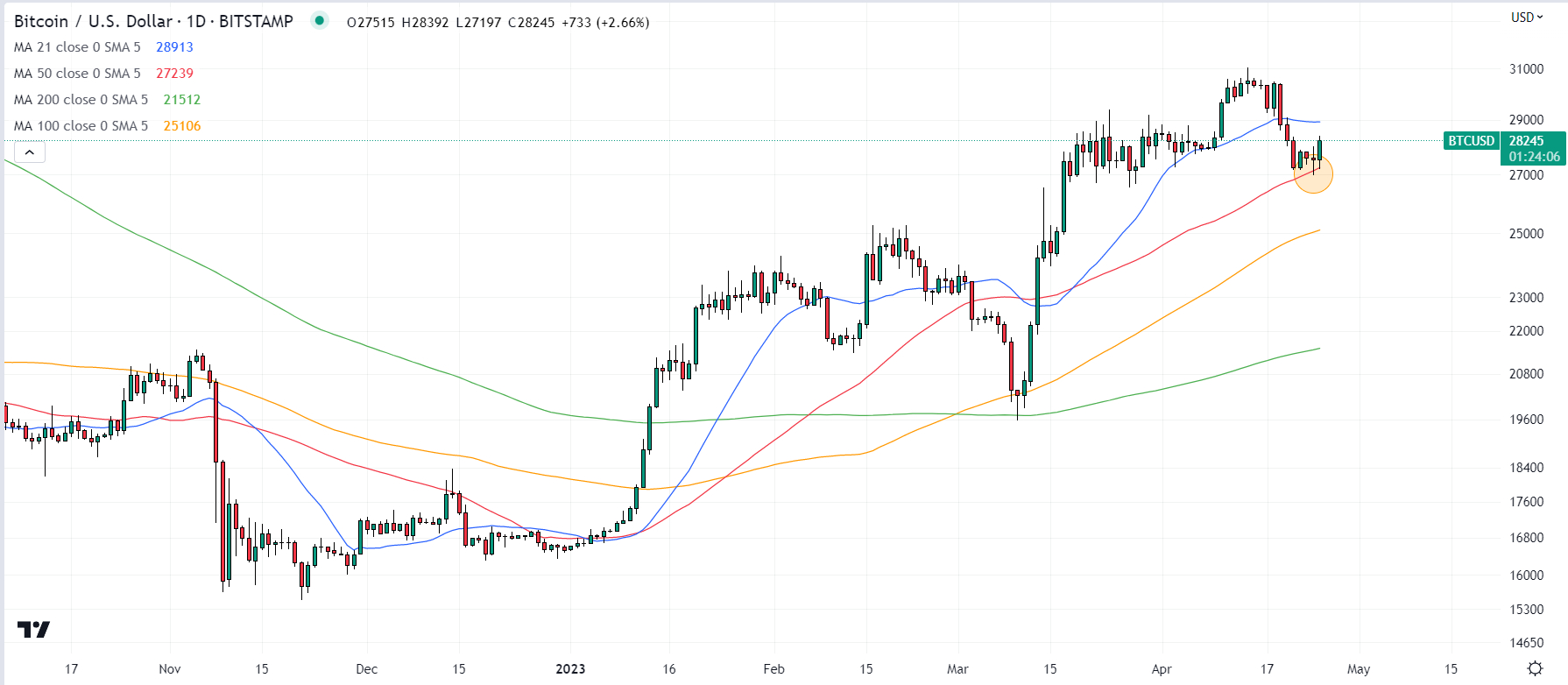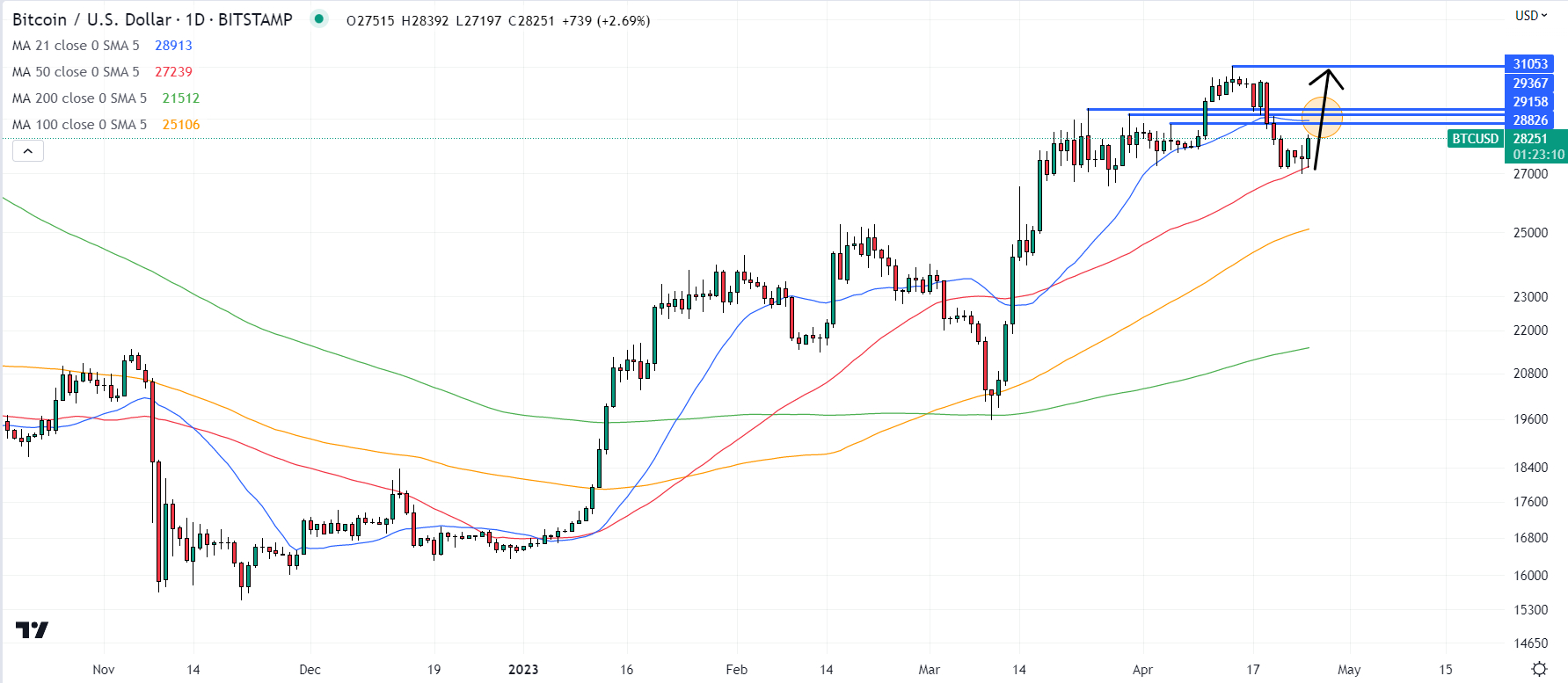The Bitcoin (BTC) price has shrugged off concerns about sudden movements in long-term dormant wallets, as well as ongoing regulatory uncertainty with Coinbase now suing the US SEC for a lack of clarity on crypto rules, and posted a strong rebound back to the north of the $28,000 level for the first time in four days.

That’s probably thanks to a surge in technical buying ahead of the 50-Day Moving Average in the $27,200s, as well as at near-term support in the form of recent lows just above $27,000.
Bitcoin’s more than 2.5% bounce on Tuesday into the $28,200s has bulls hoping that the world’s largest cryptocurrency by market capitalization may be able to post a quick jump back to the north of the $30,000 level that it briefly conquered earlier this month.
A short-term buy signal monitored by Bloomberg fired off just under one week ago when Bitcoin was changing hands just under $29,000.
Historically, BTC gains around 7% within the next 10 days following this trading signal.
If history is a good guide, then the Bitcoin price could be set for a swift rally towards $31,000 over the next three days.
That would require Bitcoin to push back above key near-term resistance levels in the form of the 21DMA near $28,900 and the late-March/early-April highs in the $28,900-$29,300 area.

But a break above this key resistance zone would open the door to further upside, given a lack of fresh notable resistance levels ahead of the year’s highs around $31,000.
Upcoming Macro Risks Could Shake Things Up
Major upcoming macro risk events such as this week’s US GDP and inflation reports followed by next week’s Fed meeting, jobs and ISM survey data could throw a spanner in the works, if they deliver a meaningful shift to the macro narrative.
Part of the rationale for this year’s Bitcoin rally, aside from safe-haven demand amid banking crisis fears and a rebound after Q4 2022’s historically oversold market conditions, has been that the Fed’s tightening cycle is nearly over.
According to the CME Fed Watch tool, the market’s base case assumption is that there will be one more 25 bps rate hike to 5.0-5.25%, followed by as much as 100 bps of rate hikes by the year’s end.
Markets seem to be assuming that an incoming credit crunch combined with the delayed impact of aggressive interest hikes will tilt the economy into recession in the second half of the year, forcing the Fed to ease financial conditions to support growth.
This is a broadly Bitcoin/crypto positive narrative, as it assumes easier financial conditions ahead, undermining arguments for a lower Bitcoin price.
Assuming that this narrative remains largely intact in the coming weeks, the Bitcoin price should remain underpinned in the medium-to-long term.
For reference, long-term on-chain indicators and analysis of Bitcoin’s longer-term market cycles, as referenced in this recent article, are sending strong signals that the cryptocurrency has entered the early stages of a new bull market.
The Bitcoin (BTC) price has shrugged off concerns about sudden movements in long-term dormant wallets, as well as ongoing regulatory uncertainty with Coinbase now suing the US SEC for a lack of clarity on crypto rules, and posted a strong rebound back to the north of the $28,000 level for the first time in four days.

That’s probably thanks to a surge in technical buying ahead of the 50-Day Moving Average in the $27,200s, as well as at near-term support in the form of recent lows just above $27,000.
Bitcoin’s more than 2.5% bounce on Tuesday into the $28,200s has bulls hoping that the world’s largest cryptocurrency by market capitalization may be able to post a quick jump back to the north of the $30,000 level that it briefly conquered earlier this month.
A short-term buy signal monitored by Bloomberg fired off just under one week ago when Bitcoin was changing hands just under $29,000.
Historically, BTC gains around 7% within the next 10 days following this trading signal.
If history is a good guide, then the Bitcoin price could be set for a swift rally towards $31,000 over the next three days.
That would require Bitcoin to push back above key near-term resistance levels in the form of the 21DMA near $28,900 and the late-March/early-April highs in the $28,900-$29,300 area.

But a break above this key resistance zone would open the door to further upside, given a lack of fresh notable resistance levels ahead of the year’s highs around $31,000.
Upcoming Macro Risks Could Shake Things Up
Major upcoming macro risk events such as this week’s US GDP and inflation reports followed by next week’s Fed meeting, jobs and ISM survey data could throw a spanner in the works, if they deliver a meaningful shift to the macro narrative.
Part of the rationale for this year’s Bitcoin rally, aside from safe-haven demand amid banking crisis fears and a rebound after Q4 2022’s historically oversold market conditions, has been that the Fed’s tightening cycle is nearly over.
According to the CME Fed Watch tool, the market’s base case assumption is that there will be one more 25 bps rate hike to 5.0-5.25%, followed by as much as 100 bps of rate hikes by the year’s end.
Markets seem to be assuming that an incoming credit crunch combined with the delayed impact of aggressive interest hikes will tilt the economy into recession in the second half of the year, forcing the Fed to ease financial conditions to support growth.
This is a broadly Bitcoin/crypto positive narrative, as it assumes easier financial conditions ahead, undermining arguments for a lower Bitcoin price.
Assuming that this narrative remains largely intact in the coming weeks, the Bitcoin price should remain underpinned in the medium-to-long term.
For reference, long-term on-chain indicators and analysis of Bitcoin’s longer-term market cycles, as referenced in this recent article, are sending strong signals that the cryptocurrency has entered the early stages of a new bull market.
